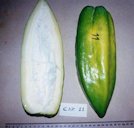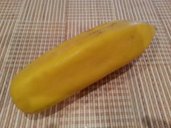| Babaco - Vasconcellea x heilbornii | |||||
|---|---|---|---|---|---|
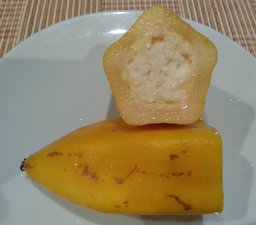 Fig. 1  Babaco cross-section, Carica pentagona 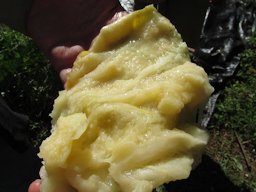 Fig. 2 Vasconcellea x heilbornii, fruit pulp, Piiholo, Maui, Hawai'i 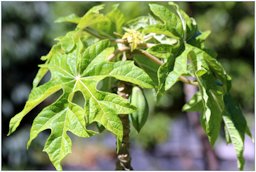 Fig. 5  C. pentagona o babaco o chamburo, Jardín Botánico Atlántico de Gijón, Spain 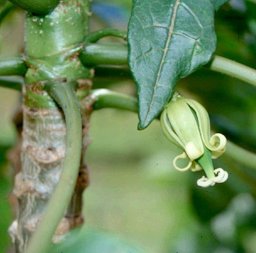 Fig. 6  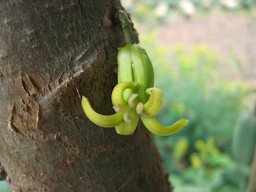 Fig. 7  Babaco flower showing cauliflory, emerging directly from the stem 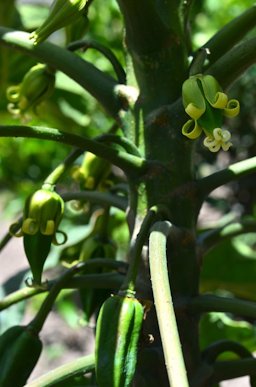 Fig. 8  Fruit forming 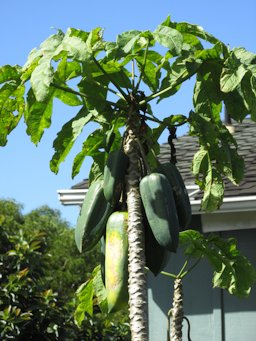 Fig. 9  V. x heilbornii babaco fruit, leaves, Piiholo, Maui, Hawai'i 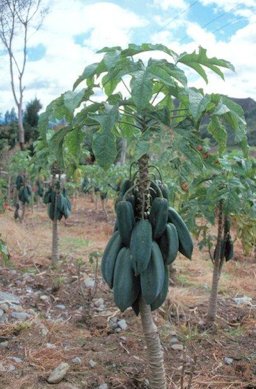 Fig. 10  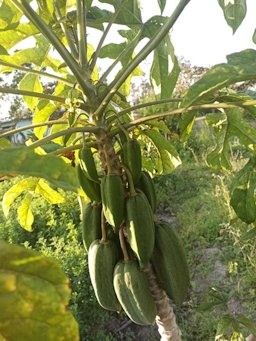 Fig. 11  Babaco, Atuntaqui, Ecuador 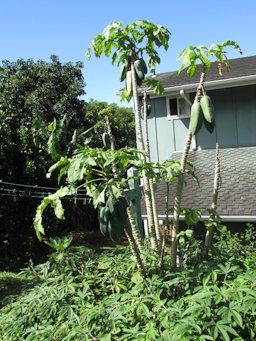 Fig. 12  V. x heilbornii babaco fruiting habit, Piiholo, Maui, Hawai'i 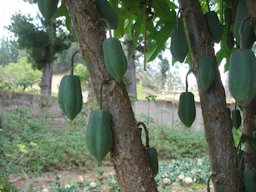 Fig. 13  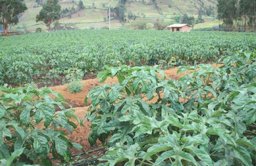 Fig. 14  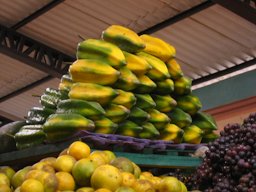 Fig. 15  V. × heilbornii, market in southern Ecuador 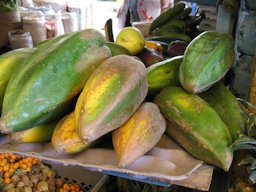 Fig. 16  Babaco, C. pentagona, Otavalo market, Ecuador 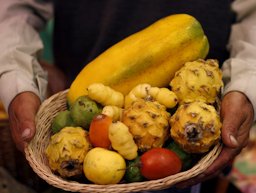 Fig. 17  Frutos de Luya, región Amazonas |
Scientific
name Vasconcellea x heilbornii (V. M. Badillo) V. M. Badillo Common names English: babaco, champagne fruit; Ecuador: toronchi, toronche; German: Babaco, Berg-Papaya; Spanish: babaco, babaco pequeño, babaco redondo, chamburo, jigacho, siglalón, siglo, toronche, toronche de Castilla, toronche de cerro, toronche pequeño, toronchi, chamburo de Castilla, papayo calentano, poronchi, toronche de Castilla 1,16 Synonyms Carica × heilbornii V.M. Badillo (basionym), C. x heilbornii nothovar. pentagona (Heilborn) V.M. Badillo, C. x heilbornii nothovar. chrysopetala (Heilborn) V.M. Badillo, C. chrysopetala Heilborn, C. pentagona Heilborn, Vasconcellea x heilbornii nothovar. chrysopetala 1,13 Relatives Papayuelo (Carica goudotiana), orange papaya (C. monoica), papaya (C. papaya), toronchi (C. pubescens), chamburro (C. stipulata) 11 Family Caricaceae (papaya family) Origin Western South America: Ecuador USDA hardiness zones 10-12 Uses Fruit; ornamental Height 5-10 ft (1.5-3 m) Crown Large leaves clustered at the apex of the plant Plant habit Semi-ligneous; single stemmed; erect 2,5 Growth rate Rapid; can attain 10 ft (3 m) in one year 2 Longevity Average lifespan is eight years 13 Trunk/bark/branches Thin-trunked shrub; fruit and stem scars; stem spongy-fibrous, gray or brown Pruning requirement Removal of side shoots and old leaves; coppiced after production 2 Leaves Alternate leaves; between five and seven lobes; prominent veins 5 Flowers Bell shaped; single or group of 2-3; cauliflory Fruit Parthenocarpic; aspermous berry; pentagonal shape; 5 well defined sides; skin green turning yellow; flesh white, acidic, aromatic 2 Season Harvest starts 10-12 months after planting 2 Light requirement Sun Soil tolerances Prefers light and well-drained deep loamy soils or sandy loams 2 pH preference 6.5-7 2,5 Flood tolerance Very susceptible to standing water 2 Aerosol salt tolerance Not tolerant Soil salt tolerance Not tolerant Cold tolerance Can withstand a few degrees of frost 14 Wind tolerance Shallow rooted, easily blown over when fully laden with fruit so wind protection is essential 14 Plant spacing 5 x 5 ft (1.5 x 1.5 m) 2 Roots Fleshy tuberous main taproot; many lateral roots; shallow root system 2,5 Invasive potential * None reported Pest resistance Very susceptible to root rot pathogens 8 Known hazard The milky latex exuded may cause dermatitis in sensitive people Reading Material Florida Babaco Fruiting, Archives of the Rare Fruit Council of Australia Babaco, a Promising Crop in New Zeland, Archives of the Rare Fruit Council of Australia Babaco, California Rare Fruit Growers Taxonomy Babaco is a natural sterile hybrid in the small dicotyledenous family Caricaceae, with papaya (Carica papaya) being its most commercially important relative. It has been assigned a variety of botanical names in the past with Carica x pentagona probably being the most widely used. However, the most recent morphological and molecular taxonomic work has placed babaco in the genus Vasconcellea, the largest genus in the family with 21 species; some of the others in this genus are edible, but usually require some cooking to become more palatable. Hybrid parental lineage is still unclear, but a common maternal ancestor with V. weberbaueri seems likely. Within the family, papaya and babaco are only distantly related. 3 It is probably a natural hybrid between Vasconcella stipulata Badillo and V. pubescens A.DC. Kuntze, known in Ecuador by the respective names of toronche and chamburo. 2,5 Origin The babaco, Vasconcella pentagona Heilborn (Caricaceae), was first identified in the 1920s. Babaco appears to have originated in the Ecuadorian province of Loja (mountain equatorial climate). Babaco has been cultivated in New Zealand since 1973 and was introduced to Europe in 1985, notably in Italy and Spain. More recently, its cultivation has spread to California. The high yield and the unusual flavour have lead to this expansion in production. 5 A number of Babaco plants (Carica pentagona) were introduced into South Florida from California in 1988 by Bill and Barbara Hopkins (Hopkins Citrus and Rare Fruit Nursery, Davie, Florida). 8 Description Babaco is a small herbaceous shrub, 5-10 ft (1.5-3 m) high but can grow taller with an erect softwood, semi-lignous trunk lined with leaf scars like papaya. It has a shallow root system with flashy tuberous roots of 15.8 in. (40 cm) diameter and numerous lateral roots. It occasionally branched around the base. Leaves are alternate, large, up to 16 in. (40 cm) across, coriaceous, green, palmate with 5-7 lobes with distinct mid rib and lateral veins like papaya and borne on long hollow petioles that radiate from the trunk. The flowers are all female and are solitary on the end of a long pendulous stalk, arising from the leaf axil. Fruits are formed parthenocarpically, an aspermous berry with no ovarian cavity and seeds, pentagonal (five-sided), with five longitudinal ridges, rounded at the stem end and pointed at the apex like a torpedo, 8-12 in. (20-30 cm) long and 4.5-7 in. (12-18 cm) wide, green turning yellow to golden yellow on ripening. The flesh is thick, whitish to cream- coloured, juicy, acid-sweet with the core filled with spongy tissues. 1 The smallish plants fit nicely in many parts of the yard, and with their broad green leaves and vertically held fruit add an exotic touch to the landscape. 12 It is especially successful as a greenhouse crop because the plant is small and needs no pollinators. 13 Leaves The alternate glabrous leaves have between five and seven lobes that can be entire or slightly divided with prominent veins in the underside and a darker green on the upper side. 2 Alternate leaves clustered at tips of shoots. Cordate leaves 16-20 in. (40-50 cm) long, with long hollow petioles. 10 The average life of a leaf is 4 to 6 months. 12 Flowers The bell-shaped pistillate flowers measure between 1.4 in. (3.5 cm) and 1.5 in. (4 cm) and grow out of the leaf axil 2-3 months after planting. They have five yellowish petals and dark green sepals. There are no staminate flowers and the tree can only be propagated asexually. 5 Flowers form on the newly developing trunk during the growth phase of the tree. Usually the thicker the trunk, the more prolific the flowering will be. The flowers, usually solitary on the end of a long pendulous stalk, arise from every leaf axil. The flowers are all female. 12 Fruit A five-sided drooping berry on a long peduncle 3-6 in. (8-15 cm), rounded at the proximal end and acute at the apex, that can grow to 12 x 6 in. (30 x 15 cm) and and weighs between 1 pd (0.5 kg) and 4.5 pd (2 kg). Seeds are usually absent but occasionally there may be a few. While the whole fruit is edible, it is usually only the white/cream-coloured mesocarp (80-85% of the fruit) below the pericarp and separate from the central spongy flesh that is preferred. The acid flesh is pleasantly aromatic but low in sugar (3-6%, comparable to tomatoes). 3 It is slightly effervescent (hence it’s other name “champagne fruit’). The flavor is unique, although it may be described as a cross between strawberry, pineapple and pawpaw [papaya]. 14 The latex (like that of pawpaws [papaya], figs etc) is quite corrosive when liquid and should be wiped away or allowed to dry up if the fruit is to be eaten raw. The riper the fruit, the less of a problem this is. 14 The fruit reaches full size about two months before maturity. The onset of maturity is further recognised by the yellowing of the fruit, (decreasing chlorophyll and increasing carotenoids), first in patches then gradually extending over the whole surface during the following two weeks,They ripen in progression from the lower fruits, which are usually the heaviest, to those higher up the trunk. 3,9 It takes about a year to reach full size, and a further 8-10 weeks to ripen. 19
Fig. 3. Unripe fruit Fig. 4. Ripe fruit Varieties There are no clearly identified cultivars of babaco and little variation in the plant’s morphological and fruit characteristics has been observed. Clones can occasionally be differentiated by fruit sugar content. The New Zealand clone ‘Connops Sweet’ has particularly sweet fruit. Plants derived from ovular calli have been used successfully to select plants for improved fruit quality and plant hardiness. 7 The babaco 13 is the most commercially advanced highland papaya. Its fruits are fragrant and flavorful, with quite a different scent and taste from the common papaya. Its distinctive flavor has been likened to the taste of strawberry with a hint of pineapple. Sweet to some palates, it is pleasantly subacid, unique and refreshing. The large, normally seedless, “zeppelinlike” fruits, some weighing 4.5 pds (2 kg), can be consumed fresh or stewed. 17 Harvesting Fruit should be picked using secateurs, leaving a short length of peduncle attached to minimise fungal rots during storage. Harvest period is staggered as fruit mature upwards on the tree. Home growers can optimise flavour by delaying picking till almost the whole fruit has turned yellow, whereas commercial growers have to harvest much earlier to allow for transport and marketing delays. If picked when mature (>10% yellow) it might take 2-3 weeks to fully ripen at room temperature; as a climacteric fruit, ethylene will speed this process. Shelf life of fully ripe fruit at >10°C is 2-4 weeks, but chilling injury will result if kept below 6°C. 3 Even without cold storage the fruit has a shelf life of four weeks. Furthermore, fruit that has been damaged will keep for a long time, since the damaged part will not spread to healthy tissue. The breakdown area can simply be cut off and the remainder eaten. Cold storage will obviously extend the life of the fruit, the optimum temperature being six degrees celsius. 9 Pollination It is interesting to note that like bananas, and unlike its close relative papaya, babaco is strictly parthenocarpic, meaning that it requires no pollination for fruit set, and that fruits produced are entirely seedless. 8 Propagation Since there are no staminate flowers, the plant can only be propagated asexually. 2 Wood for propagation is taken from the parent plant by cutting the entire trunk diagonally about 1 foot from the ground (or back to the second shoot), and making 1 foot cutting lengths from it. This should be done after fruiting but before the next flush of growth. The cuttings are then dipped in a fungicide bath and the rooting end dipped in a rooting hormone. The cuttings are then set vertically in a low-moisture medium such as sand or sandy loam to form callouses. With the first sign of roots and the beginnings of new leaves, they can be planted out, about 8 inches below ground level. Within 15 months these new plants are producing fruit. 12 Micro- propagation from shoots and axillary buds is relatively easy and enables the rapid production of a large number of healthy plants. Chamburo (V. pubescens) or toronche (V. stipulata) plants at the end of their fruiting cycle are used as rootstock. The graft is made at a height of 4 or 6 in. (10 or 15 cm). This type of propagation generates more vigorous plants, with better cold and pest resistance. 5 Culture The babaco needs at least 4.5 h of sun exposure daily, although if the sunlight is too intense leaf sunburn occurs. The plant is sensitive to wind due to its shallow root system, and the potential for leaf damage and defoliation. Slightly acidic or neutral (pH 6.5–7) sandy clay soils that are rich in organic matter (> 3%) are recommended for cultivating babaco. 5 When a young babaco plant reaches about a foot in height, it starts flowering in the same fashion as papaya from the axil of each new leaf petiole. Most of these young fruit will abort like so many small mango fruit, but if it gets cool enough along about January through March, you will be delighted to find that your plant has set some fruit for you to enjoy. Each one will enlarge over the summer into a unique five-sided (hence its species name of pentagonal) torpedo-shaped fruit, and ripen to an attractive canary-yellow color. 8 The babaco thrives in a cool subtropical climate, free of frost. 12 Excessive fluctuations in day and night temperatures, or low night temperature, even for a short time, caused babaco fruit to mature misshapen, with a rough pitted skin. 15 Pruning After 4-6 months of production, the trunk is cut back to just above the soil level. Following 8 months of regrowth, the plant is ready for another cycle of fruit production. Yield decreases with plant age and the plant is generally only exploited for four production cycles. 6 Any base side shoots should be trimmed off, leaving one major trunk for maximising fruit size and only one other to grow into a main stem when the original is losing vigour after 3-4 seasons. Spent stems should be cut back to the base and can be used as cuttings for propagation. 3 For the best results, only one trunk should be allowed to grow. Remove shoots that form around the base of the plant. In early spring, allow one of these shoots to develop. This shoot will grow rapidly but will not flower and interfere with the current season’s fruit. After harvest, prune the main stem back to 8 in. (20 cm) and the remaining shoot will now develop and become the next main trunk. 13 Irrigation Frequent regular water supply is required for plant growth and yield. Irrigation should be adapted to soil type and season; for clay soils a 12- day irrigation cycle is sufficient. Irrigation frequency should be increased for sandy soils (every 8 days during the wet season and every 4 days during the dry season). Irrigation after planting, at the start of flowering and during fruit development and maturation is crucial. 5 Water sparingly after planting as the roots are especially sensitive to excess watering just after transplanting. After that, the soil should be allowed to dry partially between watering. Overhead watering increases the risk of fungal infection and splitting of near-ripe fruit, so microspray or minisprinkler irrigation is considered best. Babaco plants require ample water for optimum production, but they dislike wet soil. 14 Fertilization During plant growth, nitrogen, potassium and magnesium supplements every 3 months are recommended. A biannual phosphorus supplement can be added. Fertilization depends on the nutritional status of the soil. 2 Diseases Overwatering and too much nitrogenous fertilizer may induce Phytophthora root rot. If this happens, plants can be propagated from portions of the trunk. 14 Food Uses The fruit is mainly consumed fresh when completely ripe. The flesh is juicy and somewhat acid in taste. It can be processed to make pasteurized and concentrated fruit juice, dehydrated fruit powder, dried fruit, marmalade and pieces in syrups. The fruit has more water, protein and organic acids than papaya and its sugar and vitamin content is lower. The two fruit have similar mineral composition. 5 Because of the low sugar content, some people like to add some honey or a sprinkle of sugar to improve the taste. 3 Being seedless, the whole fruit can be eaten including the skin and it can simply be served on its own or as a tasty ingredient of a fruit salad. Babaco juice is a popular drink in Ecuador where it is served in the top hotels. 9 Additionally, they are added to cheese cakes and dairy products like yogurt. 1 In Ecuador, the fruits are cooked with sugar and spices such as cinnamon and served as a dessert called dulce de babaco, often accompanied by ice cream or whipped cream. 10 Once ripened, babaco fruit can be frozen, or stored in a refrigerator for as long as a month (longer than carambola) with little or no degradation in quality. 8 The cut fruit also keeps well and does not turn brown (oxidize) over time 17 Medicinal Properties ** The latex is an excellent remedy for warts and can be applied to the wart several times a day until it is burned away. The Incas used Babaco to treat obesity and stress problems. The enzyme papain emulsifies fats and breaks down cholesterol and protein. 14 Other Uses The latex of unripe fruit contains proteolytic and lipolytic enzymes that are many times higher than in papaya. 3 Babaco is a rich source of proteolytic enzymes like papain which is used as a meat tenderiser. 1 In the Province of Luya, Peru, babaco liqueur is made by leaving the pulp and seeds to soak in aguardiente. In Ecuador, babaco is used to make small pastries to be shared during the Corpus Christi festivals. 18 Commercial Potential The babaco is grown commercially in Ecuador and as an export fruit in New Zealand. There is limited production in southern California where is is sometimes found in Farmers’s Markets and specialty markets. The fruit has several factors in its favor and with adequate promotion could find a wider marketing niche. The fruit is attractive when sold in a yellow ripe stage, and stores well even after it has been cut. In addition the plants are highly productive and not culturally demanding. Prunings are used for cuttings which become producing plants within a year. The compactness and productivity of the babaco plants makes it a good candidate for greenhouse production. 12 Its successful cultivation in several countries throughout the world has provided a basis for further development and marketing. Relatively little research has been conducted on the babaco, but enough reports exist to provide potential growers with general information on cultural requirements, including temperatures, media, planting density, postharvest handling, and potential diseases. Some research on the effect of light intensity for continuous cropping through-out the year is necessary. Improving the sweetness of babaco fruit could elevate its popularity to a well-recognized tropical fruit. 15 General This is an ideal species for the home grower with little space as it’s a small tree with a small footprint, and it can easily be grown in pots. Provided you like the taste, ensure adequate water and nutrient supply and use an open high organic content soil with good drainage, you’ll be rewarded with an enviable and regular supply of this unusual fruit. 3 If the plant is grown in a container, then the potting mix should contain a large proportion of perlite/bark etc, rather than peat moss which is too water retentive. 19 List of Growers and Vendors |
||||
| Bibliography 1 Lim, T. K. "Edible medicinal and non-medicinal plants, Fruits, vol. 1." ZLibrary, 2012, 1lib.us/book/1310933/1bdc97. Accessed 23 Jan. 2022. 2 Duarte, Odilo and Robert E. Paull. Exotic Fruits and Nuts of the New World. Cambridge, CABI, 2015. 3 "Babaco, also called Mountain Papaya, Vasconcellea (Carica) X heilbornii (pentagona)." The Rare Tropical Fruit Club WA, www.rarefruitclub.org.au/Babaco.htm. Accessed 22 Jan. 2022. 4 Campbell, Richard J. "South American Fruits Deserving Further Attention." Progress in new crops™, Edited by J. Janick, pp. 431-439, 1996, hort.purdue.edu/newcrop/proceedings1996/V3-431.html#Caricaceae. Accessed 22 Jan. 2022. 5 The Encyclopedia of Fruit & Nuts. Edited by Jules Janick and Robert E. Paull, Cambridge, CABI, 2008. 6 Villareal, L., et al. "Evaluation de l’intérêt du babaco (Carica pentagona Heilb.)" Fruits, 2003, doi.org/10.1051/fruits:2002035, Hal Open Science, hal.archives-ouvertes.fr/hal-0151919. Accessed 22 Jan. 2022. 7 Vega de Rojas, R., and S. L. Kitto. "Regeneration of babaco (Carica pentagona) from ovular callus." Journal of American Society of Horticultural Science, 1991, doi.org/10.21273/JASHS.116.4.747. Accessed 22 Jan. 2022. 8 Soroka, Travis. "Florida Babaco Fruiting Report." Archives of the Rare Fruit Council of Australia, Mar. 1990, rfcarchives.org.au/Next/Fruits/Papaya/FloridaBabaco3-90.htm. Accessed 24 Jan. 2022. 9 "Babaco, a Promising Crop in New Zeland." Queensland Fruit and Vegetable News, 19 May 1983, Archives of the Rare Fruit Council of Australia, rfcarchives.org.au/Next/Fruits/Papaya/Babaco9-83.htm. Accessed 24 Jan. 2022. 10 Blancke, Rolf. "Tropical Fruits and Other Edible Plants of the World: An Illustrated Guide." Zlibrary, 2016, b-ok.cc/book/3414166/f1bf9d?dsource=recommend. Accessed 24 Jan. 2022. 12 "Babaco." California Rare Fruit Growers, crfg.org/wiki/fruit/babaco/. Accessed 24 Jan. 2022. 13 Hallowes, Megan. "Babaco.' Sustainable Gardening Australia (SGA), www.sgaonline.org.au/babaco/. Accessed 25 Jan. 2022. 14 "Babaco." Sub-Tropical Fruit Club of Qld, Compiled by Bruce Hallett, STFCQ, stfc.org.au/?s=babaco. Accessed 25 Jan. 2022. 15 Kempler, Chaim, and Todd Kabaluk "Babaco (Carica pentagona Heilb.): A Possible Crop for the Greenhouse." HortScience, Vol. 31: Issue 5, Sept. 1996, doi.org/10.21273/HORTSCI.31.5.785, American Society for Horticultural Science, journals.ashs.org/hortsci/view/journals/hortsci/31/5/article-p785.xml. Accessed 25 Jan. 2022. 16 "Vasconcellea x heilbornii." New World Fruits Database, Biodiversity International, Research for development in agricultural and forest biodiversity, CGIAR, (CC BY-NC-ND 4.0), nwfdb.bioversityinternational.org/detail/?uid_fruit=440. Accessed 26 Jan. 2022. 17 "Lost Crops of the Incas: Little-Known Plants of the Andes with Promise for Worldwide Cultivation." National Research Council (U.S.), Advisory Committee on Technology Innovation, 1989, EPDF, Public Domain, epdf.pub/lost-crops-of-the-incas-little-known-plants-of-the-andes-with-promise-for-worldw.html. Accessed 26 Jan. 2022. 18 "Babaco." Ark of taste, Slow Food Foundation for Biodiversity, www.fondazioneslowfood.com/en/ark-of-taste-slow-food/babaco/. Accessed 26 Jan. 2022. 19 "Babaco." Blockhill, www.blockhill.co.nz/babaco. Accessed 26 Jan. 2022. Photographs Fig. 1 Alpha. "Cross-section - Babaco Carica pentagona from Hong's aunt." Flickr, 24 Nov. 2013, (CC BY-NC-SA 2.0), Image cropped, www.flickr.com/photos/10559879@N00/11026881256. Accessed 26 Jan. 2022. Fig. 2 Starr, Forest, and Kim. "Vasconcellea x heilbornii (Babaco, mountain papaya), Fruit eaten, Piiholo, Maui, Hawai'i." Starr Environmental, 160103-3400, 3 Jan. 2016, (CC BY 4.0), www.starrenvironmental.com/images/image/?q=26342190543. Accessed 26 July 2020. Fig. 3 Schelderman, Xavier. "Caricaceae Vasconcellea x heilbornii." International Plant Genetic Resources Institute (IPGRI), New World Fruits Database, Biodiversity International, Research for development in agricultural and forest biodiversity, CGIAR, (CC BY-NC-ND 4.0), nwfdb.bioversityinternational.org/fileadmin/templates/nwfdb/images/Caricaceae_Vasconcellea x heilbornii var pentagona_Fruit_R1_XS.jpg. Accessed 26 Jan. 2022. Fig. 4 Alpha. "Cross-section - Babaco Carica pentagona from Hong's aunt." Flickr, 24 Nov. 2013, (CC BY-NC-SA 2.0), www.flickr.com/photos/avlxyz/11026768475/in/photostream/. Accessed 26 Jan. 2022. Fig. 5 Manuel m. v. "Carica pentagona o babaco o chamburo, Jardín Botánico Atlántico de Gijón." Flickr, 24 Nov. 2013, (CC BY 2.0), www.flickr.com/photos/10559879@N00/11026881256. Accessed 26 Jan. 2022. Fig. 6 Schelderman, Xavier. "Caricaceae Vasconcellea x heilbornii." International Plant Genetic Resources Institute (IPGRI), New World Fruits Database, Biodiversity International, Research for development in agricultural and forest biodiversity, CGIAR, (CC BY-NC-ND 4.0), nwfdb.bioversityinternational.org/fileadmin/templates/nwfdb/images/Caricaceae_Vasconcellea x heilbornii var pentagona__Flower_R1_XS.jpg. Accessed 26 Jan. 2022. Fig. 7 Cherfas, Jeremy. "Relative of papaya. Babaco flowers showing cauliflory, emerging directly from the stem." Flickr, 1 Oct. 2009, (CC BY-NC-SA 2.0), www.flickr.com/photos/jcherfas/4144233834/in/photolist. Accessed 26 Jan. 2022. Fig. 8 Carter, Josh. "Babaco Bud." Flickr, 5 Aug. 2011, (CC BY-NC-SA 2.0), www.flickr.com/photos/44702416@N08/6012484360. Accessed 26 Jan. 2022. Fig. 9 Starr, Forest, and Kim. "Vasconcellea x heilbornii (Babaco, mountain papaya), Fruit leaves, Piiholo, Maui, Hawai'i." Starr Environmental, 160103-3395, 3 Jan. 2016, (CC BY 4.0), www.starrenvironmental.com/images/image/?q=26852375742. Accessed 26 July 2020. Fig. 10 Schelderman, Xavier. "Caricaceae Vasconcellea x heilbornii." International Plant Genetic Resources Institute (IPGRI), New World Fruits Database, Biodiversity International, Research for development in agricultural and forest biodiversity, CGIAR, (CC BY-NC-ND 4.0), nwfdb.bioversityinternational.org/fileadmin/templates/nwfdb/images/Caricaceae_Vasconcellea x heilbornii var pentagona_Plant_R1_XS.jpg. Accessed 26 Jan. 2022. Fig. 11 Melo, Alessa. "Babaco Vasconcellea × pentagona, Atuntaqui, Ecuador." iNaturalist, Research Grade, (CC BY-NC 4.0), www.inaturalist.org/observations/64404763. Accessed 26 Jan. 2022. Fig. 12 Starr, Forest, and Kim. "Vasconcellea x heilbornii (Babaco, mountain papaya), Fruiting habit, Piiholo, Maui, Hawai'i." Starr Environmental, 160103-3394, 3 Jan. 2016, (CC BY 4.0), www.starrenvironmental.com/images/image/?q=26852374672. Accessed 26 July 2020. Fig. 13 Cherfas, Jeremy. "Relative of papaya. Babaco flowers showing cauliflory, emerging directly from the stem." Flickr, 1 Oct. 2009, (CC BY-NC-SA 2.0), www.flickr.com/photos/jcherfas/4144233594/in/photolist. Accessed 26 Jan. 2022. Fig. 14 Schelderman, Xavier. "Caricaceae Vasconcellea x heilbornii." International Plant Genetic Resources Institute (IPGRI), New World Fruits Database, Biodiversity International, Research for development in agricultural and forest biodiversity, CGIAR, (CC BY-NC-ND 4.0), nwfdb.bioversityinternational.org/fileadmin/templates/nwfdb/images/Caricaceae_Vasconcellea x heilbornii var pentagona_crop_R1_XS.jpg. Accessed 26 Jan. 2022. Fig. 15 Hunt, Eric. "Vasconcellea × heilbornii, market in southern Ecuador." Flickr, 28 Jan. 2004, (CC BY-NC-SA 2.0), www.flickr.com/photos/ericinsf/149310238/in/photolist. Accessed 26 Jan. 2022. Fig. 16 Vilseskogen. "Babaco: Carica pentagona, Otavalo market, Ecuador." Flickr, 26 Jan. 2008, (CC BY-NC 2.0), www.flickr.com/photos/vilseskogen/2670323091/. Accessed 26 Jan. 2022. Fig. 17 "Frutos de Luya, región Amazonas." APEGA Sociedad Peruana de Gastronomía, 11 Sept. 2011, Flickr, (CC BY-NC-SA 2.0), Image cropped, www.flickr.com/photos/67312912@N06/6138515078. Accessed 26 Jan. 2022. * UF/IFAS Assessment of Non-native Plants in Florida's Natural Areas ** Information provided is not intended to be used as a guide for treatment of medical conditions. Published 29 Jan. 2022 LR |
|||||
